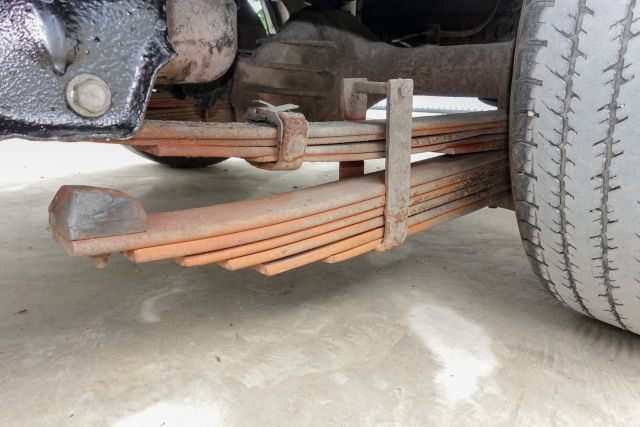Flat springs
Contents |
Introduction
Flat springs are flat strips of material which, when deflected by an external load, store and release energy. These types of spring are small, stamped metal components that function like a spring by controlling deflection within small or restricted spaces.
Manufactured from high carbon spring steel, nickel-silver, high nickel alloys and stainless steel, a flat spring can function as a spacer or ground.
Applications
Flat springs come in a range of different shapes and sizes for various applications. They are used for numerous purposes within differing industries, such as motors, office equipment, generators, counterbalances, doors and electrical switchgear.
There are many different types of flat spring including the leaf spring and flat coil spring.
Leaf Spring
Leaf springs are one of the oldest forms of spring, dating back to medieval times, they are an important component in suspension, such as in cars or other vehicles. They provide stability and help minimise wear and tear on other parts.
Created with individual layers or leaves of metal, they are often used in automotive design on drive or steer axles. Constructed of high alloy spring steel or lighter weight materials such as low carbon steel, this type of spring comes in three basic types; mono-leaf springs, multi-leaf springs and parabolic springs.
Mono-Leaf Spring
A mono-leaf spring consists of one plate of springs which is thick in the centre and tapers out to the ends. The amount and length of the taper is critical to the durability and safety of the spring. This type of spring provides lesser spring rates that can hold up a vehicle, also offering less stiffness in terms of bending and controlling the axle.
Multi-Leaf Spring
A multi-leaf spring is an engineered system designed to provide support, stability and safety to a vehicle. The length and make-up of each spring is important as each leaf is designed to carry a proportionate amount of load and stress. Each leaf is designed to provide support to the leaf above and below it, and it is this feature which provides support for the vehicle.
Parabolic Spring
A parabolic spring is a leaf or set of leaves which are tapered in a parabolic form rather than in a linear one. The tapering in a single leaf handles the force distribution from the vehicle to the axle, and works as a complete multi-leaf spring. Parabolic springs design is characterised by fewer leaves the thickness of which varies from the centre to ends following a parabolic curve, preventing unwanted inter-leaf friction. They tend to have more flexibility and are commonly used on buses.
Flat Coil Springs
Flat coil springs are used with a counterweight to control the action of valves, such as those in a vehicle exhaust system. They are wound into a specific configuration to absorb shocks or provide tension, and can be found in seating to provide support, or in automotive applications.
--European Springs and Pressings Ltd 12:46, 15 Nov 2017 (BST)
Related articles on Designing Buildings Wiki
- Compression springs.
- Key qualities of springs.
- Mechanical engineer.
- Spring materials.
- Tension springs v torsion springs.
- Torsion springs and their benefits.
- Using springs in construction to prevent disaster.
- Spotlight On: Flat Springs
- Spotlight on Compression Springs
- The Difference Between Tension and Torsion Springs
- The Importance of Gas Springs
- The Multiple Uses of Compression Springs
- The Uses of Wire Forms Within the Construction Industry
- Types of spring.
Featured articles and news
Infrastructure that connect the physical and digital domains.
Harnessing robotics and AI in challenging environments
The key to nuclear decommissioning and fusion engineering.
BSRIA announces Lisa Ashworth as new CEO
Tasked with furthering BSRIA’s impressive growth ambitions.
Public buildings get half a million energy efficiency boost
£557 million to switch to cleaner heating and save on energy.
CIOB launches pre-election manifesto
Outlining potential future policies for the next government.
Grenfell Tower Inquiry announcement
Phase 2 hearings come to a close and the final report due in September.
Progress from Parts L, F and O: A whitepaper, one year on.
A replicated study to understand the opinion of practitioners.
ECA announces new president 2024
Electrical engineer and business leader Stuart Smith.
A distinct type of countryside that should be celebrated.
Should Part O be extended to existing buildings?
EAC brands heatwave adaptation a missed opportunity.
Definition of Statutory in workplace and facilities management
Established by IWFM, BESA, CIBSE and BSRIA.
Tackling the transition from traditional heating systems
59% lack the necessary information and confidence to switch.
The general election and the construction industry
As PM, Rishi Sunak announces July 4 date for an election.
Eco apprenticeships continue help grow green workforce
A year after being recognised at the King's coronation.
Permitted development rights for agricultural buildings
The changes coming into effect as of May 21, 2024.























